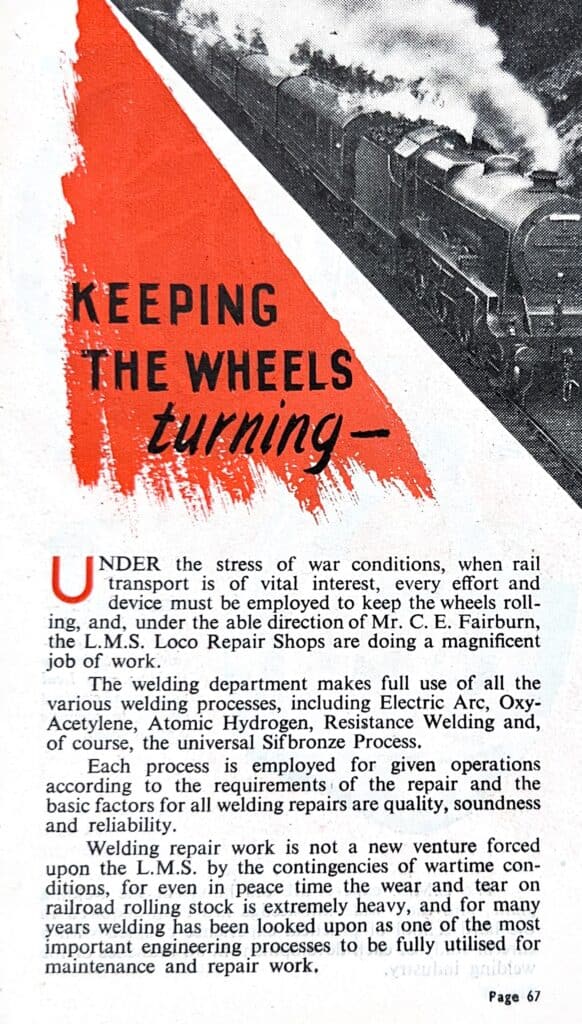Introduction
During the height of World War II, rail transport was the lifeline of the war effort. The need to move troops, equipment, and supplies efficiently and reliably was paramount. Amidst the chaos, the L.M.S. (London, Midland and Scottish Railway) Loco Repair Shops, under the guidance of Mr. C. E. Fairburn, became a beacon of excellence, ensuring the wheels kept turning. Central to their success was the innovative use of Sifbronze, developed by the Suffolk Iron Foundry (SIF), founded in 1925.
The Challenge
Wartime conditions imposed severe stress on railway infrastructure. The constant movement of heavy military cargo caused extensive wear and tear on rolling stock. The L.M.S. Loco Repair Shops faced the daunting task of maintaining and repairing these crucial assets without disrupting the war effort. Traditional welding methods were often inadequate for the diverse and demanding repair needs.
Comprehensive Welding Techniques
The welding department at the L.M.S. Loco Repair Shops employed a variety of welding techniques, each suited to specific repair tasks. These included Electric Arc, Oxy-Acetylene, Atomic Hydrogen, and Resistance Welding. However, the universal hero in their arsenal was the Sifbronze process. This versatile welding method became indispensable for ensuring the quality, soundness, and reliability of repairs.

- Electric Arc Welding:
- Provided strong, durable joints for a wide range of applications.
- Oxy-Acetylene Welding:
- Perfect for precise control in cutting and welding thin materials.
- Atomic Hydrogen Welding:
- Known for high-temperature, clean welds, ideal for specialized applications.
- Resistance Welding:
- Efficient for joining thin sheets and components, crucial in manufacturing processes.
- Sifbronze Process:
- The go-to solution for many repairs, particularly effective for cast iron and other difficult materials.
The Sifbronze Advantage
Sifbronze, developed by the Suffolk Iron Foundry, was a game-changer. Its low-temperature process (operating at approximately 950°C, compared to the 1500°C required for fusion welding) significantly reduced issues related to localized distortion and cracking in the weld-affected zone. This made it particularly valuable for field repairs, where ideal conditions were hard to achieve.
- Adaptability:
- Sifbronze was used for various repairs, from fixing broken lugs to rebuilding missing pieces, especially in cast iron parts.
- Its effectiveness under less-than-ideal preheating conditions made it a reliable choice for mobile units.
- Reliability:
- The Sifbronze process consistently produced strong, durable joints, ensuring the repaired parts could withstand continuous use.
- Its performance in the field earned it a reputation as a dependable solution for critical repairs.
A Welder’s Testimony
F. B., a welder in the R.A.F., shared his experiences with Sifbronze. He had been using it for three years and found it indispensable for daily tasks. On mobile units, where heavy preheating equipment was unavailable, Sifbronze proved its worth. F. B. often improvised with petrol tins filled with sand and blow lamps to preheat jobs, yet Sifbronze consistently delivered reliable results, even without precise preheating.
Historical Impact
The role of Sifbronze during World War II highlights the importance of innovation in overcoming engineering challenges. The success of the L.M.S. Loco Repair Shops in maintaining the railway infrastructure was crucial to the war effort. By ensuring that trains could transport troops and supplies efficiently, they directly contributed to the broader success of military operations.
Conclusion
This case study celebrates the invaluable contribution of the Suffolk Iron Foundry’s Sifbronze process in supporting wartime rail transport. The innovative use of Sifbronze not only solved immediate welding challenges but also ensured the continuous operation of critical railway services. The legacy of Sifbronze underscores the importance of reliable, adaptable, and innovative engineering solutions in times of crisis.
Through the eyes of welders like F. B. and the dedicated efforts of the L.M.S. Loco Repair Shops, the story of Sifbronze comes to life. It is a story of ingenuity, resilience, and the relentless pursuit of excellence that kept the wheels turning during one of the most challenging periods in history.
4o
Article Links –
- The Railway at War – https://www.networkrail.co.uk/stories/film-the-railway-at-war-1939-1945/
- References –
- The Railway at War: 1939-45 – https://www.youtube.com/watch?v=97l9CenSPtM
